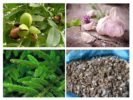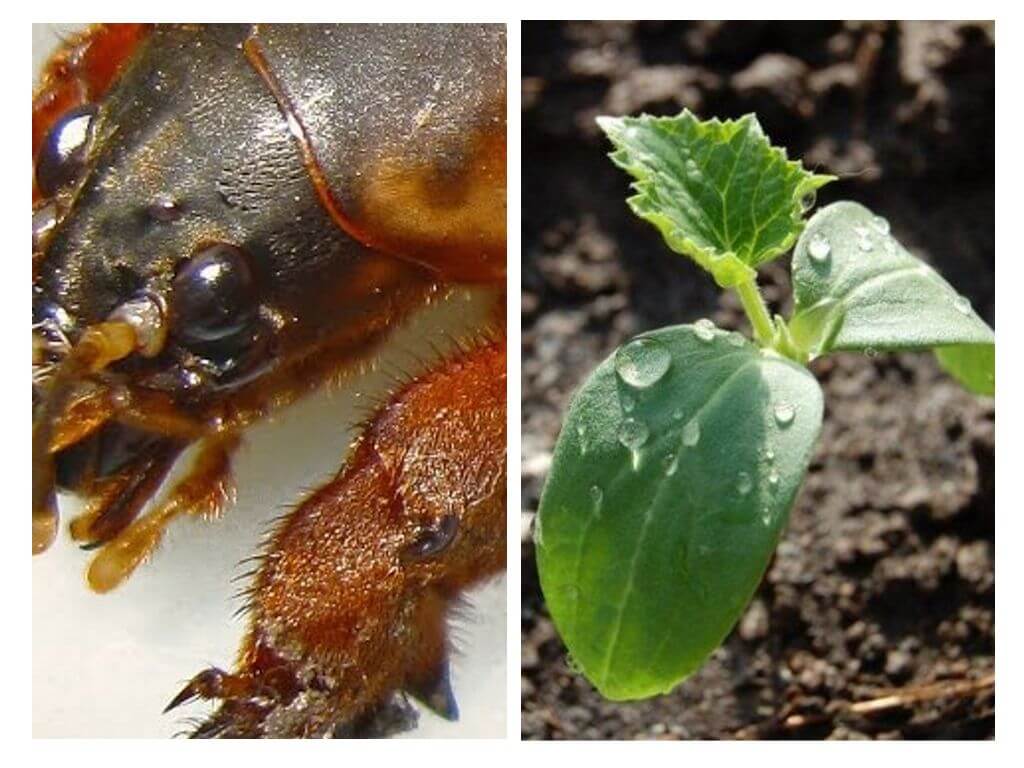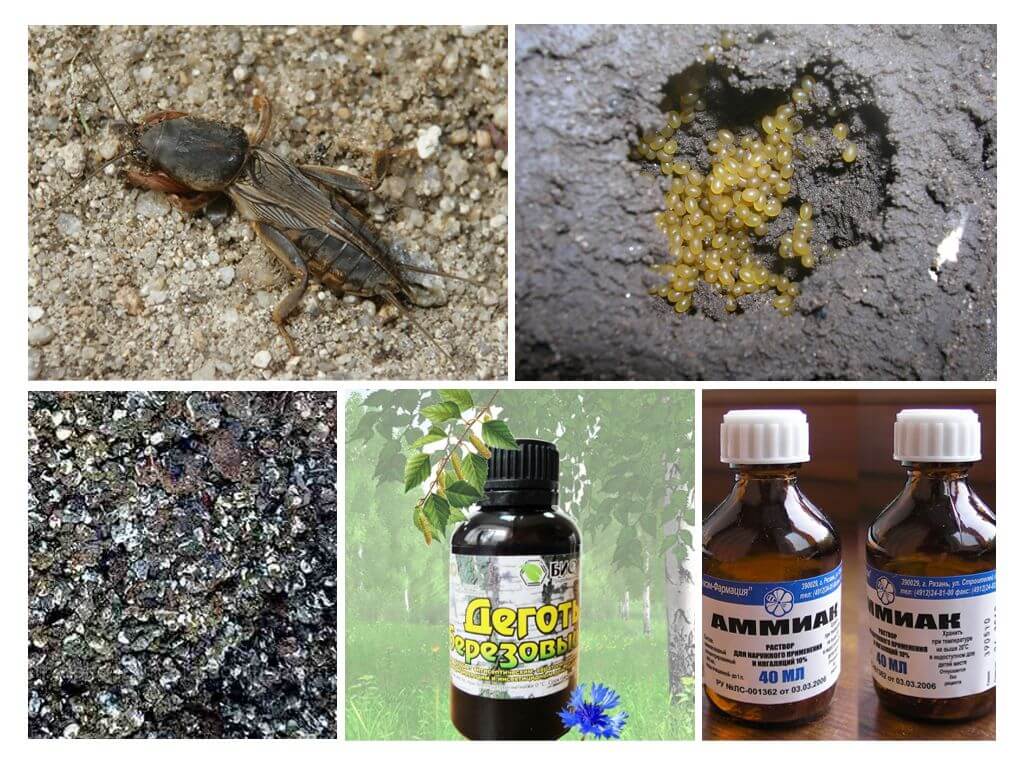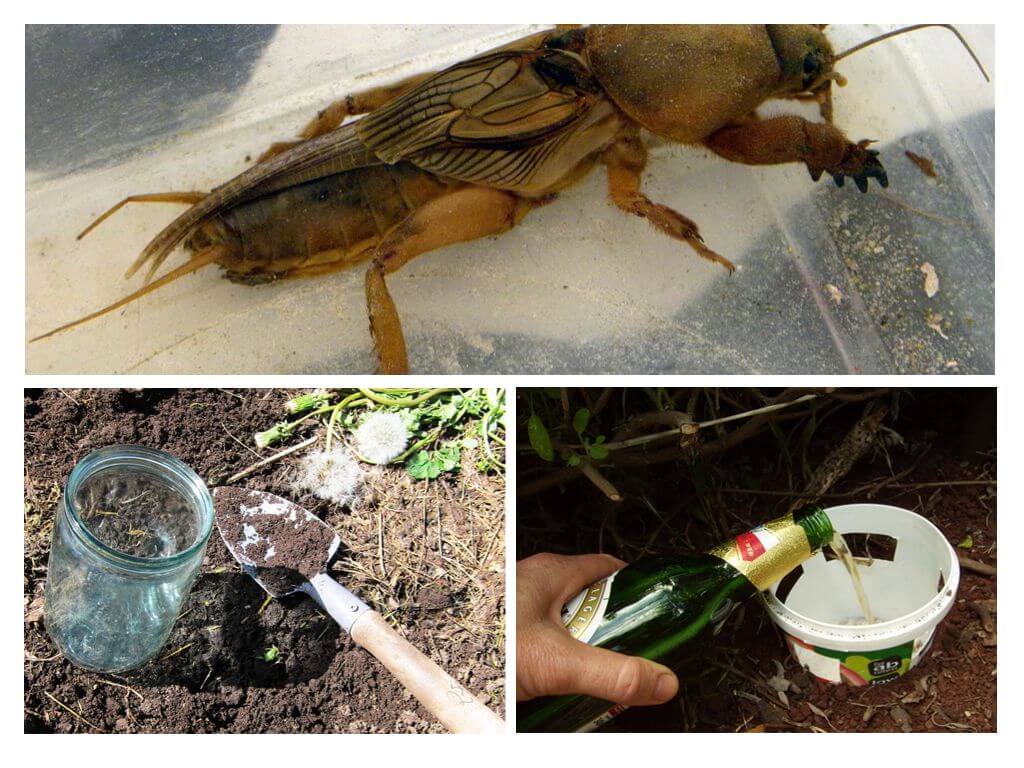- Planting cucumbers
- Save the tomato from the bear
- Folk remedies for the bear
Bear in the garden - The most dangerous enemy of seedlings, young plants. The pest builds numerous passages in the soil at a depth of 5 to 70 cm, destroying everything in its path. It feeds on roots, plant stems, parts that are underground. You can notice the presence of pests on the bed along the path of traces on the soil, dried plants, holes in the ground. How to protect seedlings from a bear, every gardener thinks. Better to prevent troubles right away than to fix mistakes later.
Planting cucumbers
Protection of seedlings from the bear is carried out by folk remedies, without use of poisonto preserve the natural value of the vegetable.
- Dig holes about 20 cm deep.
- Mix soil with earth, pour into prepared pits.
- Gently remove seedlings from the original packaging together with the ground.
- Cut the bottom in plastic cups and cut them in half. On one plant you need 2 halves.
- Place the seedlings with the ground in one half, attach the other. In this position, insert into the hole, sprinkle with soil.
- The edges of the cup should protrude 1.5 cm. When the seedlings harden, they can be easily pulled out.
Such a simple design will help protect cucumbers from the bear, other parasites. Additionally, to scare insects, a clove of garlic is dug next to cucumbers.
On a note!
Seeds of cucumbers when placed directly in the soil of the garden can also be protected with folk remedies. One way is to crush eggshellmix with vegetable oil. Place in wells, lightly sprinkle with earth. Sow the seeds. Such a simple method of struggle can save cucumbers and other crops. The bear does not like sharp objects, stumbling on the edges of the shell, will continue to bypass.
Planting tomatoes
You can protect seedlings from the bear at the planting stage.
- Plastic bottles allow you to create a safe space for the normal formation of the root system of the plant. Cut the neck, cut the bottom. Place the seedlings. You can immediately plant tomatoes in such a container. Then, before planting in the garden, just cut the bottom. Remove the bottle after the appearance of the ovary, when the tomatoes get stronger, the stem will form.
- To save tomatoes will help ammonia. He is bred in water. 10 liters of liquid requires 2 tbsp. tablespoons of ammonia. Around the plant at a distance of 10 cm make a small depression. Watered with a solution to this border so that the liquid does not get to the roots, the green part of the plant. Ammonia repels the bear with a pungent odor, high nitrogen content in the soil. Another way to protect the seedlings from the bear is to dig a cotton swab around the plant, a rag soaked in ammonia.
- You can protect tomatoes birch tar. Impregnated with sawdust in a solution of tar, spread in the holes when planting. Or dig around, slightly sprinkling with earth. Tar has a strong odor that repels the bear, other harmful insects. Soaking the seedlings from the bear will help soaking the root of the plants before planting in a solution of birch tar. For 3 liters of water use 1 tbsp. a spoonful of the drug.
- Dig pine and spruce branches on the bed next to each plant. They keep a smell for a long time, frighten off a bear.So you can get rid of pests throughout the garden plot.
- When planting, put the teeth of garlic, nuts in the hole.
To save seedlings will help the right fertilizer. When planting in the garden use chicken droppings. Mix in the soil when planting a plant. Subsequently, the green part of the plant is sprayed once a week. Useful for tomatoes, scares away the bear, other harmful insects.
Preventive measures

You can secure your garden in the fall, if you take this problem seriously.
- The nests of the bear are located at a depth of 5 to 50 cm from the surface of the soil. In autumn, you need to dig a bed approximately at such a depth. Broken passages, nests, eggs are on the surface, the larvae die. Repeat in spring before planting.
- So that the bear does not eat garden crops, you need to scatter manure on the land in the fall. During the winter, the bear’s eggs will die, which she likes to lay there.
- Dig a hole near the land, cover it with plastic wrap. Throw manure there. Bears closer to fall will begin to hide there, build a shelter for wintering. With the onset of persistent cold weather, dig a pile with manure. Eggs, larvae, adults will die, because they will not be able to dig frozen ground.
You can reduce the number of bears in the garden plastic bottle traps. Dig a small hole, dig a bottle under the slope. Pour some beer. Cover the hole with plywood, a piece of linoleum. About 12 animals are caught in one bottle. If there is a lantern in the garden, leave it on for the night, place a bucket of soapy water under it. Bears fly into the light, hit a lantern, fall into the water.
To protect seedlings, seeds in the garden from pests, you need to deal with the entire land, and not a separate garden bed.









Before planting seedlings, I wrap each tomato in a newspaper and sheets from a glossy magazine. They have been saving the plant for 3 seasons, the neighbor suggested.
I will sprinkle crushed eggshells into the holes, nothing more. Medvedka bypasses these beds side.
And I add garlic to the shell. It also works well. And you can, in general, plant a bed with tomatoes, cucumbers between garlic. Then nothing needs to be done.
I plant marigolds, marigold, chrysanthemums between the garden beds between the beds. Excellent repel all sorts of pests, not just the bear. When landing, I use plastic cups, as described in the article. Then I remove them.
The easiest way is pine, spruce branches. If the forest is near, no problems, costs. And for fertilizer use chicken manure instead of cow manure. The first scares away the bear, the second attracts.
Agree. Our neighbors around us cannot get rid of pests. We process plants, soil with chicken droppings, managed to remove.
From cucumbers, glasses can not be pulled out, let them grow like that. This will not affect the formation of the fruits, and the soft roots of the bear can damage at any stage.
I plant seedlings after pre-soaking in birch tar. It helps well, does not harm the plant.
This is if the little bear is small, you can use one thing. We use traps, insecticides, and folk methods. We have been fighting for 2 years. Probably have to change the composition of the soil - to import sand. In wet chernozem, they settle much more readily.
I plant tomatoes in the greenhouse. I protect the entire structure from the bear. I dig around a small moat, pour sand soaked in kerosene.